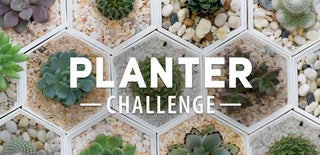Introduction: Self-watering Downspout Planter
What is better than a planter that doesn't need to be watered every day? A planter that doesn’t need to be watered, because it waters itself with rainwater. I designed this planter to fit snugly into holes cut into a standard 3” x 2” downspout and bring a bit of environmentally-friendly color to any house.
That you will need:
3D Printed parts:
Basked
Reservoir
Tools:
Ruler and pen
[Alternatively, you could print out the layout directly and tape or glue it onto the downspout. ]
Drill and drill bits [1/2” bit and a smaller bit for a pilot hole]
Files and sandpaper
[I recommend a bit of thin tape to dull any sharp edges during handling.]
Shears [Alternately, a Dremel or similar device.]
Safety Glasses and Gloves
Plants or seeds [Including any kind of starter, plant food, etc.]
Step 1: Prepare the 3D Printed Parts
Print the Basket and Reservoir.
I used PLA on a Prusa I3 MK2 at .1mm layer highs. No supports on the Basket, and only one small support on the Reservoir. Feel free to make it a colorful as you like or to color code the different plants.
Step 2: Prepare Your Tools.
You will need the following:
Ruler and pen [To layout the holes]
[Alternatively, you could print out the layout directly and tape or glue it onto the downspout. Make sure it is not scaled during printing.]
Drill and drill bits [1/2” bit for the top hole and the starter hole, and a smaller bit to make a pilot hole.]
Files and sandpaper [To smooth the holes]
[I recommend a bit of thin tape to dull any sharp edges during handling.]
Shears [To cut out the bottom hole, although you could use a Dremel or similar device.]
Safety Glasses and Gloves [Always a must. Protect those eyes and hands!]
[IMPORTANT: Corners and edges will be sharp. USE CAUTION.]
[Children will need to be supervised by a responsible adult.]
Step 3: Prepare Your Plants.
Get whatever you seeds or plants you want on hand; including any plant food, starter, or fertilizer you wish to use. Small plants are recommended since the basked is only 1¾”x2¾”x2”, so anyone looking to plant redwoods may have an unhappy time of it.
Step 4: Lay Out Your Cuts.
Use the dimensions on the template to draw where you need to cut and drill. Alternately, print out the template use it directly by gluing or taping it to the downspout. [Be sure it does not scale during printing.]
Attachments
Step 5: Drill Your Holes.
Step A:
Using the smaller drill bit make a pilot hole, centered for the upper hole and 1/4" from the edge for the bottom hole.
Step B:
Widen the holes with the 1/2" bit. [Make sure the downspout is securely held so that the bit doesn't catch and swing it.] [If the lower pilot hole was 1/4" from the line, the widened hole should just touch the line.]
[IMPORTANT: Corners and edges will be sharp. USE CAUTION.]
Step 6: Cut Out the Lower Hole.
Starting with where the drill hole touches the line of the lower hole, cut out the hole using the sheers. You may have to go past the corners in order to get the sheer to make nice crisp edges.
[IMPORTANT: Corners and edges will be sharp. USE CAUTION.]
Step 7: Prep the Edges
Step A:
Using a file or some sandpaper, smooth the edges. You may also need to bend the edges straight if they got warped by the sheer.
Step B:
Put office tape, or other thin tape, onto the edges. This will greatly reduce the chance of cutting yourself on an edge.
[IMPORTANT: Corners and edges will be sharp. USE CAUTION.]
Step 8: Insert the Reservoir.
Gently but firmly slide the reservoir into the holes and slide down as Illustrated. The holes have been designed to be tight enough to hold everything steady; but if something isn't fitting, you may need to go back and widen or adjust a hole or corner.
Attachments
Step 9: Plant and Insert.
Plant the basket, making sure the soil goes all the way down, so it can wick up moisture. Then insert the basket into the reservoir.
Happy Growing!

Runner Up in the
Planter Challenge










